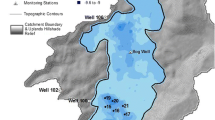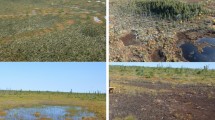Abstract
Peatlands often show patterns of small-scale topographic self-organization, such as hummock and hollow assemblages. When attempting to characterize peatland pore-water quality, little attention is typically paid to the micro-site characteristics of the sampling location, or only one microtopographical form is sampled for consistency. However, no information exists regarding whether or not these microtopographic landforms exert a direct influence over, or are influenced by, the chemistry of peat pore waters beneath them. As part of a larger study examining the role of peatlands in catchment-scale methylmercury cycling, the pore waters beneath several peatland microtopographical landforms were sampled for methylmercury. Porewater methylmercury (MeHg) concentrations at the water table followed the trend: Shallow Hollow > Lawn > Hummock > Deep Hollow, with the shallow hollows having pore-water methylmercury concentrations over 3.5 times higher than that found in deep hollows. There was no significant difference in MeHg concentrations in pore waters from −25 cm. More detailed profiles of MeHg, sulfate and DOC concentrations, and pH in a poor fen shallow and deep hollow and a raised bog hollow show strong differences in porewater solute chemistry, suggesting a complex interplay among hydrology, biogeochemistry, and microtopography. Evidence of wide variation in pore-water quality between sites and over time has significant implications for the sampling approaches used to characterize peatland pore-water chemistry.
Similar content being viewed by others
Literature cited
Benoit, J. M., C. C. Gilmour, and R. P. Mason. 1999. Estimation of mercury-sulfide speciation in sediment pore waters using octanol-water partitioning and implications for availability to methylating bacteria. Environmental Toxicology and Chemistry 18:138–2141.
Bloom, N. S. and W. F. Fitzgerald. 1988. Determination of volatile mercury species at the picogram level by low temperature gas chromatography with cold-vapor atomic fluorescence detection. Analytica Chimica Acta 208:151–161.
Branfireun, M. 2000. The role of decomposing plant litter in methylmercury cycling in a boreal poor fen. M.Sc. Thesis. McGill University, Montreal, Quebec, Canada.
Branfireun, B. A., A. Heyes, and N. T. Roulet. 1996. The hydrology and methylmercury dynamics of a Precambrian Shield headwater peatland, Water Resources Research 32:1785–1974.
Branfireum, B. A. and N. T. Roulet. 2002. Controls on the fate and transport of methylmercury in a boreal headwater catchment, northwestern Ontario. Hydrology and Earth Systems Science. 6: 785–794.
Branfireun, B. A., N. T. Roulet, C. A. Kelly, and J. W. M. Rudd. 1999. In situ sulphate stimulation of mercury methylation in a boreal peatland: toward a link between acid rain and methylmercury contamination in remote environments. Global Biogeochemical Cycles 13:743–750.
Foster, D. R., G. A. King, P. H. Glaser, and H. E. Wright. 1983. Origin of string patterns in boreal peatlands. Nature 306:256–258.
Gilmour, C. C., G. S. Riedel, M. C Ederington, J. T. Bell, J. M. Benoit, G. A. Gill, and M. C. Stordal. 1998. Methylmercury concentrations and production rates across a trophic gradient in the northern Everglades. Biogeochemistry 40:327–345.
Heyes, A., T. R. Moore, J. W. M. Rudd, and J. J. Dugoua. 2000. Methyl mercury in pristine and impounded boreal peatlands, Experimental Lakes Area, Ontario, Canadian Journal of Fisheries and Aquatic Sciences. 57:2211–2222.
Horvat, M., N. S. Bloom, and L. Liang. 1993. Comparison of distillation with other current isolation methods for the determination of methyl mercury compounds in low level environmental samples. Part 1. Sediments. Analytica Chimica Acta 281:135–152.
Hunt, R. J., D. P. Krabbenhoft, and M. P. Anderson. 1997. Assessing hydrogeochemical heterogeneity in natural and constructed wetlands. Biogeochemistry 39:271–293.
King, J. K., J. E. Kostka, M. E. Frischer, F. M. Saunders, and J. A. Jahnke. 2001. A quantitative relationship that demonstrates mercury methylation rates in marine sediments are based on the community composition and activity of sulfate-reducing bacteria. Environmental Science and Technology 35:2491–2496.
Kolka, R. K., D. F. Grigal, E. S. Verry, and E. A. Nater. 1999. Mercury and organic carbon relationships in streams draining forested upland/peatland watersheds. Journal of Environmental Quality 28:766–775.
Krabbenhoft, D. P., J. P. Hurley, M. L. Olson, and L. B. Cleckner. 1998. Diel variability of mercury phase and species distributions in the Florida Everglades. Biogeochemistry 40:311–325.
Mikkela, C., I. Sundh, B. H. Svennson, and M. Nilsson 1995. Diurnal variation in methane emission in relation to the water-table, soil-temperature, climate and vegetation cover in a Swedish acid mire. Biogeochemistry 28:93–114.
Waddington, J. M. and N. T. Roulet. 1996. Atmosphere-wetland carbon exchanges: scale dependency of CO2 and CH4 exchange on the developmental topography of a peatland. Global Biogeochemical Cycles 10:233–245.
Author information
Authors and Affiliations
Rights and permissions
About this article
Cite this article
Branfireun, B.A. Does microtopography influence subsurface pore-water chemistry? Implications for the study of methylmercury in peatlands. Wetlands 24, 207–211 (2004). https://doi.org/10.1672/0277-5212(2004)024[0207:DMISPC]2.0.CO;2
Received:
Revised:
Accepted:
Issue Date:
DOI: https://doi.org/10.1672/0277-5212(2004)024[0207:DMISPC]2.0.CO;2




